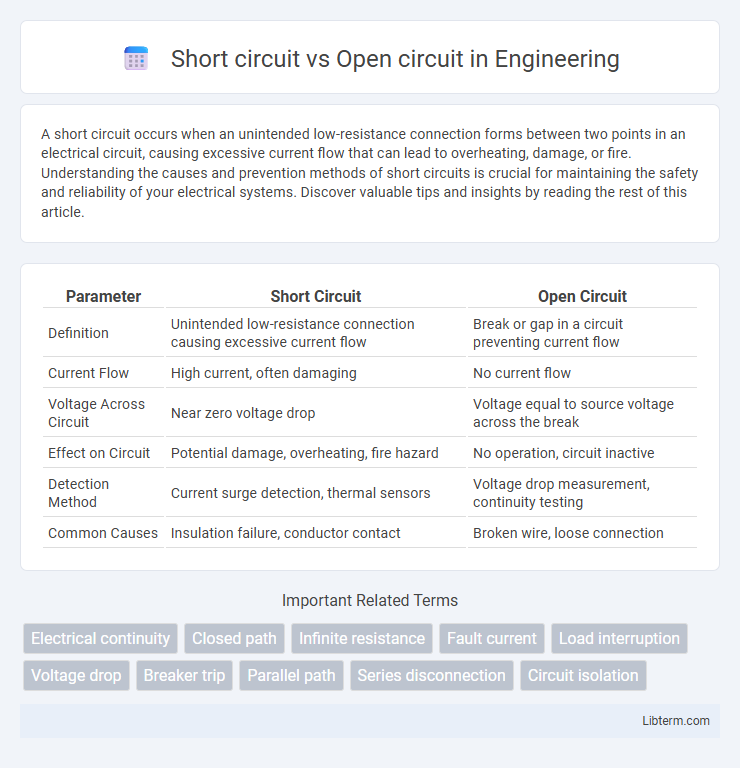A short circuit occurs when an unintended low-resistance connection forms between two points in an electrical circuit, causing excessive current flow that can lead to overheating, damage, or fire. Understanding the causes and prevention methods of short circuits is crucial for maintaining the safety and reliability of your electrical systems. Discover valuable tips and insights by reading the rest of this article.
Table of Comparison
| Parameter | Short Circuit | Open Circuit |
|---|---|---|
| Definition | Unintended low-resistance connection causing excessive current flow | Break or gap in a circuit preventing current flow |
| Current Flow | High current, often damaging | No current flow |
| Voltage Across Circuit | Near zero voltage drop | Voltage equal to source voltage across the break |
| Effect on Circuit | Potential damage, overheating, fire hazard | No operation, circuit inactive |
| Detection Method | Current surge detection, thermal sensors | Voltage drop measurement, continuity testing |
| Common Causes | Insulation failure, conductor contact | Broken wire, loose connection |
Introduction to Short Circuits and Open Circuits
A short circuit occurs when an unintended low-resistance path forms, causing excessive current flow that can damage electrical components or cause fires. An open circuit happens when a break or disconnection in the electrical path prevents current from flowing, resulting in device malfunction or power loss. Understanding the differences between short circuits and open circuits is critical for diagnosing electrical faults and ensuring system safety.
Definition of Short Circuit
A short circuit occurs when an unintended low-resistance path forms between two points in an electrical circuit, allowing excessive current to flow and potentially causing damage or hazards. This fault bypasses the normal load, leading to a rapid increase in current that can cause overheating and equipment failure. In contrast, an open circuit breaks the continuity of the circuit, stopping current flow completely and preventing any operation of connected devices.
Definition of Open Circuit
An open circuit occurs when there is a break or disconnection in a conducting path, preventing current from flowing through the circuit. Unlike a short circuit, which creates an unintended low-resistance path causing excessive current, an open circuit results in zero current flow due to interruption. This interruption can be caused by a broken wire, a disconnected component, or a switch in the off position, leading to a halt in electrical operation.
Key Differences Between Short Circuit and Open Circuit
A short circuit occurs when an unintended low-resistance path allows excessive current to flow, potentially causing damage or fire, whereas an open circuit happens when the circuit path is broken, preventing current flow entirely. Short circuits often result in a sharp increase in current and can trigger protective devices like fuses or circuit breakers, while open circuits cause devices to stop working due to the interruption of electrical continuity. Understanding these key differences is crucial for diagnosing electrical faults and ensuring safe circuit operation.
Causes of Short Circuits
Short circuits typically occur due to damaged insulation, loose or exposed wiring, and accidental contact between conductive elements. These faults cause excessive current flow by creating a low-resistance path, often leading to overheating and potential electrical fires. Common causes include physical wire damage, moisture intrusion, and manufacturing defects in electrical components.
Causes of Open Circuits
Open circuits occur when there is a break or disconnection in the electrical path, often caused by damaged wiring, loose connections, or broken components. Corrosion, physical damage, and wear and tear over time also contribute significantly to open circuit conditions. Identifying these causes is crucial for effective troubleshooting and restoring proper circuit functionality.
Effects and Risks of Short Circuits
Short circuits cause excessive current flow, leading to overheating, potential fires, and damage to electrical components, posing serious safety hazards. In contrast, open circuits interrupt current flow, preventing operation without typically causing immediate damage or fire risk. Understanding short circuit effects is crucial for implementing protective devices like fuses and circuit breakers to mitigate risks and ensure electrical system safety.
Effects and Consequences of Open Circuits
Open circuits interrupt the flow of electric current, causing devices to stop functioning and potentially leading to system failure or downtime. The absence of current flow can result in voltage spikes that may damage sensitive electronic components, and in critical systems, open circuits can trigger safety hazards or operational malfunctions. Unlike short circuits, which often cause overheating or fire risks, open circuits mainly lead to signal loss, reduced efficiency, and equipment inoperability.
Prevention and Safety Measures
Short circuits can be prevented by installing appropriate circuit breakers and fuses designed to interrupt excessive current flow immediately. Open circuits require regular maintenance and inspection to ensure all connections are secure and cables are intact, preventing unexpected circuit interruptions. Implementing proper grounding techniques and using insulated wiring materials enhances overall safety and reduces the risk of electrical hazards in both scenarios.
Practical Applications and Real-World Examples
Short circuits are commonly encountered in electrical safety devices like circuit breakers, preventing damage by quickly interrupting excessive current flow in household wiring and automotive systems. Open circuits are frequently observed in troubleshooting scenarios, such as identifying broken connections in LED lighting or faulty wiring in electronic devices, where a loss of continuity halts current flow. Practical applications exploit these conditions to protect circuits and diagnose faults, ensuring the reliability and safety of electrical and electronic systems.
Short circuit Infographic

 libterm.com
libterm.com